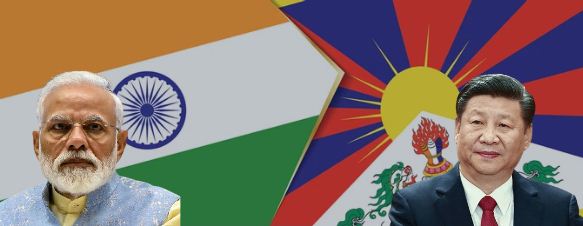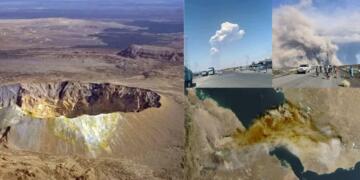India’s Tibet policy under Prime Minister Narendra Modi entered a new era last month. Prime Minister’s public birthday wishes to the Dalai Lama and Xi Jinping’s sudden visit to Tibet signals a big change in India’s Tibet policy.
Modi’s Tibet policy unfurled in multiple phases. The first phase began on the day he took his oath in 2014, where the then-president of the Tibetan Government in exile, Lobsang Sangay, was invited to Modi’s oath-taking ceremony. It can be said that Modi started his Prime Minister tenure by playing the Tibet card against China.
Modi has played the Tibet card multiple times in the first few years of his tenure. The Dalai Lama visiting Rashtrapathi Bhavan in 2016 is one such instance. When the Doklam Standoff between India and China was at its peak in 2017, India, Lobsang Sangay, hoisted the Tibetan flag in the Indian Territory of Pangong Tso Lake.
There was a policy reversal by the Modi government in 2018. Both India and China were working to build a better rapport with each other through events like “Wuhan Spirit” and “Chennai Connect”, where the leaders of both countries met each other for an informal summit in Wuhan and Chennai.
This made the Indian government rein in its rhetoric on issues regarding Tibet as the government did not wish to jeopardize its newfound rapport with the Chinese. This was visible in 2018 when an Indian government circular instructed its officials not to take part in events related to the 60th year of the flight of the Dalai Lama to India. Relations between India and China remained smooth with minimal issues in 2018 and 2019.
At this point, some experts even speculated that this smooth sailing of affairs would bring an end to the traditional border conflict between both countries, in the upcoming years or decades. Of course, this was yet to be determined as the Tibet issue stayed a hush-hush.
Things changed in 2020 with the first case of Covid-19 emerging in China and spreading across the world and making India one of the worst-hit countries. When the Indian economy was crumbling under the pressure of full lockdown and stock market halts, the Chinese became aggressive on the Indian border, which ultimately led to the Galwan border clash between Indian and Chinese soldiers. This completely changed the dynamics of Sino-Indian relations.
Returning to the rosy phase of 2018 – 2019 did not seem possible in the near future. India was forced to change its entire approach and attitude towards its bigger aggressive neighbour. It was put in a situation to reverse its Tibet Policy after maintaining keeping it subdued for two years. This change was first visible when BJP senior leader Ram Madhav tweeted a picture of him attending the funeral of a martyred soldier who was from the Special Frontier Force comprising of Tibetan soldiers. He mentioned the word “Indo- Tibetan border” instead of “Indo-Chinese Border” in his tweet. Although he had deleted the tweet, however, it is a fact that the tweet had anguished the Chinese.
Read More: China is writhing like a decapitated snake after PM Modi pressed its tender nerve “Tibet”
Despite the disengagements between both the countries at the border in recent months, the change in their Tibet policy had become completely explicit last month, when Prime Minister Modi publicly wished Dalai Lama on his birthday, which had not been done by an Indian Prime Minister anytime earlier.
It was followed by a strong Chinese reaction when Chinese President Xi Jinping visited Tibet for the first time as President. This was the first time a Chinese President was visiting Tibet after 30 years. He visited Nyingchi, which is just 17 kms from the Indian Border at Arunachal Pradesh. China had built a high-speed railway network from Tibet’s capital Lhasa to Nyingchi, which can be used to carry armed forces rapidly. On the other hand, India is currently building proper road networks on the border.
China is also building a massive dam on the Brahmaputra in the same place, which is also a cause of concern for India. Such issues will make sure that India’s Tibet Policy turns more aggressive towards China and Xi Jinping’s surprise visit to Tibet hints at the same.
The Dalai Lama’s agenda and Modi’s agenda were not in sync for the past 7 years unlike now where their interests have aligned. When Xi Jinping assumed the presidency in 2013, the Dalai Lama was optimistic that Xi would bring an end to the issue of Tibet as Xi Jinping’s father Xi Zhongxun was a close friend of the Dalai Lama.
The Dalai Lama believed that Xi Jinping was an admirer of Tibetan culture and the closeness of some of Xi Jinping’s family members to Buddhism added to Dalai Lama’s optimism. This was around the same time when Modi had played Tibetan card multiple times and the results were not as effective due to the difference in agendas.
However, Xi Jinping started acting contrary to Dalai Lama’s expectations and his Tibet Policy became more aggressive. China started crushing Tibet’s religion, ethnicity and culture and power was emphasized to the United Front Work Department that manages China’s Tibet policy.
China even went on to state that it will play the main role in picking the next Dalai Lama, raising huge concerns amongst the community. When the Dalai Lama realized his misjudgment of Xi Jinping, India had already started maintaining subdued rhetoric on the Tibetan issue from 2018. But, after the advent of the pandemic and the Galwan clashes PM Modi and the Dalai Lama were on the same page.
During his visit to Tibet, Xi Jinping also visited the Dalai Lama’s palace in Lhasa and narrated a speech where he implicitly asked Tibetans to adapt to the culture of the Chinese Communist Party. Currently, China is indulging in misadventures at the Indo- Tibet border by deploying missiles, building railways and dams. So, naturally, to counter Chinese belligerence, Modi and the Dalai Lama reached a common understanding. This will possibly lead to an enhanced and rigorous Tibet policy from India, providing Tibet with a much bigger role in shaping India – China relations.
The author of this piece is Sai Ganesh Sritharan, Founder of Tamil Regional Media Venture Desiya Siragugal, Nationalist, Columnist and Foreign Policy buff.

































lol.. aren’t you expecting too much from a weak out dated medieval bureaucratic system..